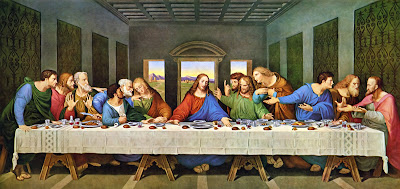On Good Friday, our family remembered Jesus' last hours by hearing the Godly Play story, "Jesus and the 12". This is an enrichment story in Godly Play: Volume 4 - Spring about the Christ's last meal with his disciples before his crucifixion. I have to say that I had largely overlooked this story until my friend, Helen, mentioned that she was going to be telling it to some children before Easter. She inspired me to take a closer look at the story and I decided to give it a try as well.
The materials for the story are Leonardo Da Vinci's painting, The Last Supper . . .
 |
| This is a restored version that I found on Google images. I printed it and mounted it on a wooden board. |
and the shields of the twelve Apostles used in the Pentecost story.
Since Helen was telling the story in a Russian-speaking context, she decided to use a painting other than Da Vinci's - this one by the Russian icon painter, Simon Ushanov. I briefly considered using another painting as well, since I have never been a big fan of The Last Supper, and there are some obvious problems with it. One is the Renaissance dress and architecture in the picture, which is a far cry from being Jewish. (The first thing my 7-year-old daughter said when she saw it was, "Did the Upper Room really look like that?") Secondly and unfortunately, the only figure in the painting that looks remotely Jewish is Judas. But the reason that I decided to use it anyway is that the apostles all look so wonderfully human in their reactions to Jesus' prophecy that one of them will betray him that night. You see anger, bewilderment, shock, horror and sadness in their faces - the same reactions that each one of us might have had.
The story then goes on to examine each of the individual apostles and the reasons for the various symbols on their shields. The Wondering questions for this story have a unique twist and provide a great opportunity to ponder their significance both on an overarching level in the biblical narrative and on a personal level:
What disciple do you like the best?
Which one do you think is the most important?
Which one do you think is most like you?
Which one could we leave out and still have everything we need for the story?
My son liked John and Peter the best. John, because he was a true friend, and Peter, because he liked to take action. My husband felt that he was most like Thomas - always asking the hard questions. And I identified with James and Thaddeus who both travelled a lot to tell the story of Jesus.
Both of my children were amazed/shocked by the number of disciples who became martyrs. The German version of the GP story states in different ways that these men were killed by people who did not understand them or their message. I think both of my kids identify with being misunderstood, because they are first of all third culture kids and then have the double whammy of being pastors' children in a highly secular society. I sensed they were comforted to know that Jesus' friends were misunderstood as well.
Afterwards, we had communion together and used the crown of thorns bread that we had baked earlier that morning. (This is a tradition that I started last year.)
As you can see, we had a lot of fun making the dough!
We also managed to finish up some pysanky. Here my daughter is melting off the wax to reveal the painted design. Her first egg broke, so she was thrilled to have this one turn out.
I completed the day by joining a friend at the Taize Good Friday service in the Berliner Dom (Berlin Cathedral)!
. . .
Wir haben Karfreitag zu Hause mit dem eigenen Mini-Familiengottesdienst verbracht. Zuerst haben wir die Godly Play-Geschichte, "Jesus und die Zwölf" gehört. Sie ging um das letzte Abendmahl und die Lebensgeschichten der 12 Jünger. Das Material dafür war das berühmte Gemälde von Leonardo Da Vinci, "Das Abendmahl" und die kirchlichen Schilder mit Symbolen darauf für die Jünger. Wir haben danach uns gefragt, welcher mir am besten gefällt und welcher von ihnen ist am meisten wie ich? Es war eine gute Möglichkeit die Jünger näher anzugucken und fragen, was es für uns heute bedeutet.
Danach haben wir Abendmahl zusammen gefeiert und benutzen einen Teigkranz, die wir am Vormittag gebacken haben, als das Brot dafür. Noch haben wir Ostereier angemalt. Es war ein schöner, nachdenklicher Tag!














































